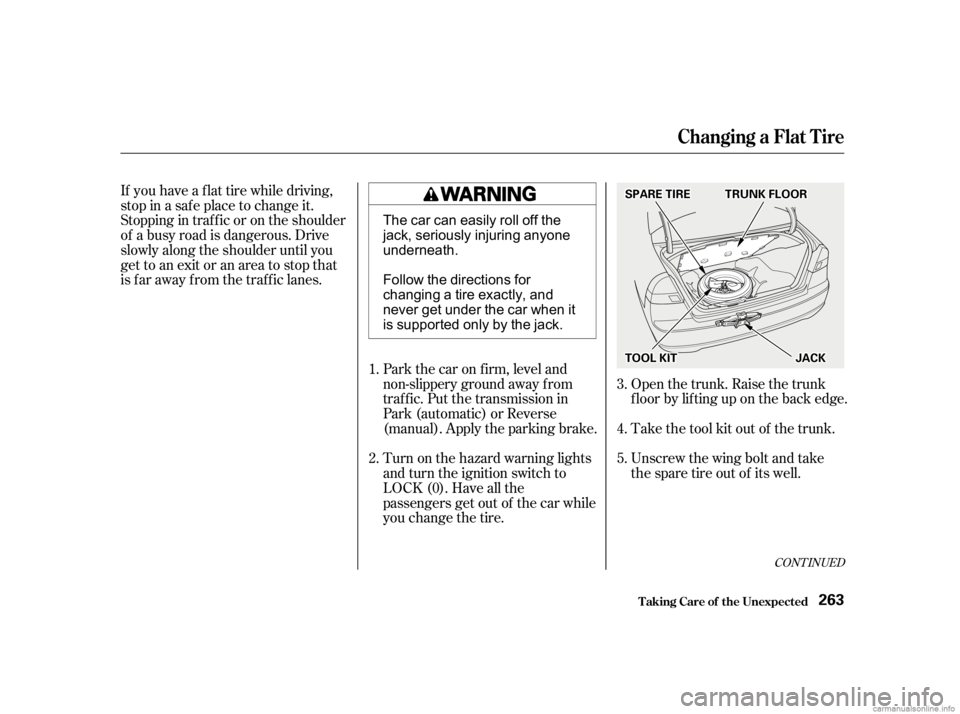Page 254 of 323

Block the rear wheels.
Fill the f uel tank.
Change the engine oil and f ilter
(see page ).
Wash and dry the exterior
completely.
Cleantheinterior.Makesurethe
carpeting, floor mats, etc. are
completely dry.
Leave the parking brake off. Put
the transmission in Reverse
(5-speed manual) or Park
(automatic).
If you need to park your car f or an
extended period (more than one
month), there are several things you
should do to prepare it f or storage.
Proper preparation helps prevent
deterioration and makes it easier to
get your car back on the road. If
possible, store your car indoors.
If the car is to be stored for a
longer period, it should be
supported on jackstands so the
tires are of f the ground.
Leave one window open slightly (if
the car is being stored indoors).
Disconnect the battery.
Support the f ront wiper blade
arms with a f olded towel or rag so
they do not touch the windshield.
To minimize sticking, apply a
silicone spray lubricant to all door
and trunk seals. Also, apply a
vehiclebodywaxtothepainted
surfaces that mate with the door
and trunk seals.Coverthecarwitha‘‘breathable’’
cover, one made f rom a porous
material such as cotton.
Nonporous materials, such as
plastic sheeting, trap moisture,
which can damage the paint.
If possible, run the engine f or a
while periodically (pref erably once
amonth).
If you store your car f or 12 months
or longer, have your Honda dealer
perf orm the inspections called f or in
the24monthsmaintenanceschedule
(Normal Conditions) as soon as you
take it out of storage (see page ).
The replacements called f or in the
maintenance schedule are not
needed unless the car has actually
reached that time or mileage.
207
196
Maint enance
St oring Your Car
251
Page 266 of 323

If you have a f lat tire while driving,
stop in a saf e place to change it.
Stopping in traf f ic or on the shoulder
of a busy road is dangerous. Drive
slowly along the shoulder until you
gettoanexitoranareatostopthat
is far away from the traffic lanes.Open the trunk. Raise the trunk
f loor by lif ting up on the back edge.
Take the tool kit out of the trunk.
Unscrew the wing bolt and take
the spare tire out of its well.
Park the car on f irm, level and
non-slippery ground away f rom
traf f ic. Put the transmission in
Park (automatic) or Reverse
(manual). Apply the parking brake.
Turn on the hazard warning lights
and turn the ignition switch to
LOCK (0). Have all the
passengers get out of the car while
you change the tire.
5. 4. 3.
2. 1.
CONT INUED
Changing a Flat T ire
T aking Care of t he Unexpect ed263
S SP PA
A R
REE T
TI
IRRE E T
TR
RU UN NKK F
FLLOOO ORR
T
T O
OO OLL K
KIITT J
JAA C
CKK
The car can easily roll off the
jack, seriously injuring anyone
underneath.
Follow the directions for
changing a tire exactly, and
never get under the car when it
is supported only by the jack.
Page 271 of 323

Diagnosing why your engine won’t
start f alls into two areas, depending
on what you hear when you turn the
key to START (III):When you turn the ignition switch to
START (III), you do not hear the
normal noise of the engine trying to
start. You may hear a clicking sound
or series of clicks, or nothing at all.
Check these things:
You hear nothing, or almost
nothing. The engine’s starter
motor does not operate at all, or
operates very slowly.
You can hear the starter motor
operating normally, or the starter
motor sounds like it is spinning
f aster than normal, but the engine
does not start up and run. Check the transmission interlock.
If you have a manual transmission,
the clutch pedal must be pushed
all the way to the f loor or the
starter will not operate. With an
automatic transmission, it must be
in Park or Neutral.
Turn the ignition switch to ON (II).
Turn on the headlights and check
their brightness. If the headlights
are very dim or don’t light at all,
the battery is discharged. See
on page . Turn the ignition switch to START
(III). If the headlights do not dim,
check the condition of the f uses. If
thefusesareOK,thereisproba-
bly something wrong with the
electrical circuit f or the ignition
switch or starter motor. You will
need a qualif ied technician to
determine the problem. (See
on page .)
If the headlights dim noticeably or
go out when you try to start the
engine, either the battery is dis-
charged or the connections are
corroded. Check the condition of
the battery and terminal connec-
tions (see page ). You can
then try jump starting the car from
a booster battery (see page ).
270 286
226 270
If Your Engine Won’t Start
T aking Care of t he Unexpect ed
Nothing Happens or the Starter
Motor Operates Very Slowly
Jump Starting Emergency T owing
268
Page 273 of 323

If your car’s battery has run down,
you may be able to start the engine
by using a booster battery. Although
this seems like a simple procedure,
you should take several precautions.
You cannot start a Honda with an
automatic transmission by pushing
or pulling it.To jump start your car, f ollow these
directions closely:
Open the hood and check the
physical condition of the battery
(see page ). In very cold
weather, check the condition of
the electrolyte. If it seems slushy
or like ice, do not try jump starting
until it thaws. Turn of f all the electrical acces-
sories: heater, A/C, stereo system,
lights, etc.
Put the transmission in Neutral or
Park and set the parking brake.
1.
2.
226
Jump Starting
T aking Care of t he Unexpect ed270
A battery can explode if you do
not follow the correct procedure,
seriously injuring anyone
nearby.
Keep all sparks, open flames,
and smoking materials away
from the battery. If a battery sits in extreme cold, the
electrolyte inside can f reeze.
Attempting to jump start with a f rozen
battery can cause it to rupture.
Page 276 of 323

CONT INUED
Saf ely pull to the side of the road.
Put the transmission in Neutral or
Park and set the parking brake.
Turn of f the heating and cooling
system and all other accessories.
Turn on the hazard warning
indicators.
If you see steam and/or spray
coming f rom under the hood, turn
of f the engine.If you do not see steam or spray,
leave the engine running and
watch the temperature gauge. If
the high heat is due to overloading
(climbing a long, steep hill on a
hot day with the A/C running, f or
example), the engine should start
to cool down almost immediately.
If it does, wait until the tempera-
ture gauge comes down to the mid-
point then continue driving.
If the temperature gauge stays at
the red mark, turn of f the engine.
Wait until you see no more signs
of steam or spray, then open the
hood.Look f or any obvious coolant leaks,
such as a split radiator hose.
Everything is still extremely hot,
so use caution. If you f ind a leak, it
must be repaired bef ore you
continue driving (see
on page ).
If you don’t f ind an obvious leak,
check the coolant level in the
radiator reserve tank (see page ). If the level is below the
MIN mark, add coolant to halfway
between the MIN and MAX marks.
1.
2.
3.
4.
5.6.
7.
286
165
T aking Care of t he Unexpect ed
If Your Engine Overheats
Emergency
Towing
273
Page 289 of 323

�µ
�µ �µ
The tow
truck uses two pivoting arms that go
under the tires (f ront or rear) and lif t
them of f the ground. The other two
tires remain on the ground. If your car needs to be towed, call a
prof essional towing service or, if you
belong to one, an organization that
provides roadside assistance. Never
tow your car behind another vehicle
with just a rope or chain. It is very
dangerous.
There are three popular types of
prof essional towing equipment.
The operator
loads your car on the back of a truck. Release the parking brake.
Shif t the transmission to Neutral.
The tow
truck uses metal cables with hooks
on the ends. These hooks go around
parts of the f rame or suspension and
the cables lif t that end of the car of f
the ground. Your car’s suspension
and body can be seriously damaged.
If your Honda cannot be transported
by f lat-bed, it should be towed by
wheel-lif t equipment with the f ront
wheels of f the ground. If due to
damage, your car must be towed
with the f ront wheels on the ground,
do the f ollowing: Release the parking brake.
Start the engine.
ShifttoD,thentoN.
Turn of f the engine.
5-speed Manual Transmission
Automatic Transmission
Wheel-L if t Equipment
Flat -bed Equipment Sling-t ype Equipment
T his is
an acceptable way to tow your
Honda. This is the best way to transport
your Honda. T his method of towing is
unacceptable.
Emergency T owing
T aking Care of t he Unexpect ed286
Improper towing preparation will
damage the transmission. Follow the
above procedure exactly. If you cannot
shif t the transmission or start the
engine (automatic transmission), your
car must be transported with the f ront
wheels of f the ground.
Page 294 of 323
The Engine Number is stamped into
the engine block.
The Transmission Number is on a
label on top of the transmission.
Identif ication Numbers
T echnical Inf ormation291
E EN
NG GIINNE E N
NUUMM B
BEER
R
M
M
A
AN
NU UAAL
L T
TR
RA A N
NS SMM I
ISSS SIIOON N
N
NU UMM B
BEER
R A
A
U
UT TO
OM M A
AT
TI
ICC T
TR
RA A N
NS SMM I
ISSS SIIOON N N
NUUMM B
BEER
R
Page 295 of 323

�Î�Î�Î
�Î �Î
�Î
�Î
�Î
�Î
�Î
�Î
�Î
�Î
�Î
�Î
�Î
Specif ications
T echnical Inf ormation292
Dimensions
Weights
Engine Capacities
174.6 in (4,435 mm)
67.3 in (1,710 mm)
56.9 in (1,445 mm)
103.1 in (2,620 mm)
57.9 in (1,470 mm)
57.9 in (1,470 mm)
2.95 x 3.72 in (75.0 x 94.4 mm) 11.9 US gal (45
, 9.9 Imp gal)
1.00 US gal (3.8
, 0.84 Imp gal)
101.7 cu-in (1.668 cm
)
9.5
9.9
Length
Width
Height
Wheelbase
Track
Gross vehicle weight rating See the certification label attached
to the driver’s doorjamb.
Type
BorexStroke
Displacement
Compression ratio
Spark plugs Water cooled 4-stroke
SOHC , SOHC VTEC
4-cylinder gasoline engine Fuel tank
Engine
coolant
Engine oil
Automatic
transmission
fluid1.03 US gal (3.9
, 0.86 Imp gal)
1.32 US gal (5.0
, 1.10 Imp gal)
1.29 US gal (4.9, 1.08 Imp gal)
3.4 US qt (3.2
, 2.8 Imp qt)
3.7 US qt (3.5, 3.1 Imp qt)
3.2 US qt (3.0, 2.6 Imp qt)
3.5 US qt (3.3, 2.9 Imp qt)
4.4 US qt (4.2, 3.7 Imp qt)
1.6 US qt (1.5, 1.3 Imp qt)
1.7 US qt (1.6, 1.4 Imp qt)
2.9 US qt (2.7, 2.4 Imp qt)
6.2 US qt (5.9, 5.2 Imp qt)
2.6 US qt (2.5
, 2.2 Imp qt)
4.8 US qt (4.5, 4.0 Imp qt)
Including the coolant in the reserve tank and that remaining in the
engine.
Reserve tank capacity: 0.21 US gal (0.8
, 0.18 Imp gal)
See spark plug maintenance
section page 225 .
Excluding the oil remaining in the engine.
Front
Rear
Approx.
1:
2:
3:
4:
1 : DX, LX
2:EX
DX, LX
EXChange
Manual
Automatic
Total Manual
Automatic
Change
Without filter
Total
Change
Total
Change
Total
U.S. Cars
Canada Cars
12
1
2 1
2
3
4
3
4
Manual trans-
mission fluidIncluding filter
Windshield
washer reservoir